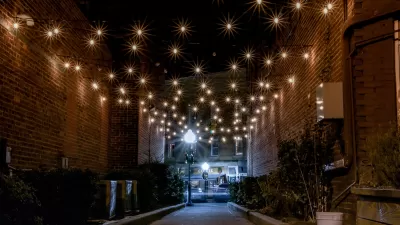Many of the Best Picture nominees are set in cities, and none are focused on suburbia.

Even if popular culture does not shape public attitudes towards cities and suburbs, it certainly reflects those attitudes. For example, 1990s television shows like Friends and Seinfeld reflected the growing popularity of urban life.
Many of this year's Oscar nominees involve urban settings as well, at least for parts of the movie. Of course, there are exceptions: one of the Best Picture nominees, Dunkirk, occurs on a depopulated beach where British soldiers and sailors are trying to evacuate France. Obviously, it makes no sense to describe Dunkirk as relevant to urbanism. Similarly, The Post mostly takes place indoors. Although it is certainly set in Washington, D.C., I cannot say that it has a strong urban or suburban emphasis. But other Best Picture nominees are more relevant to urban surroundings.
For example, in Call Me By Your Name, the characters all live within biking distance of a small Italian town. The town is a lovely example of pre-automobile small-town urbanism, with short buildings and streets narrower than those of any city in North America, and bicycles everywhere. I rate this movie NU, for New Urbanist.
Three Billboards Outside Ebbing, Missouri also takes place in a walkable small town. Two of the major characters are police officers working in a walkable American downtown, and the female lead’s curio store appeared to me to be within walking distance of downtown. But in this movie, unlike Call Me By Your Name, suburbia rears its head: the billboards in question are on a highway, and the police chief, an admirable character, is portrayed as living in large-lot suburbia with no visible houses or sidewalks nearby.
The Shape of Water, set in 1962, also occurs in a land of low-rise urbanism; the heroine lives in a mixed-use Baltimore neighborhood above a movie theatre, and takes the bus to work. Public transit also plays a small role in Darkest Hour; near the end of the movie, Winston Churchill takes the London subway to ask the opinions of the citizenry, and is heartened by the populace's fighting spirit.
In Get Out, the city is portrayed positively, but only by comparison to the sinister country. The male lead apparently lives in an urban apartment, but is driven to his girlfriend’s family’s cabin in the woods, which is clearly accessible only by automobile. In this exurban location, he meets with many horrific misadventures. In Get Out, the exurbs are a land of villainy. Phantom Thread, like Get Out, involves characters transitioning between a city (London) and a non-urban environment of country houses. However, it did not seem to me that the characters' adventures in either the city or the country were disproportionately ominous. Get Out struck me as pro-urban, while Phantom Thread was neither pro- nor anti-urban.
Finally, Lady Bird occurred in the semi-suburbia of Sacramento, California; most adult characters drive, but the title character does some walking here and there. Most of the streets seem to have sidewalks, but the downtown is somewhat invisible.
But by and large, the Oscar nominees don’t appear to be particularly anti-urban or pro-suburban. They mostly are not set in conventional suburbia, and nothing in them suggests that suburbia is normal or that cities are not. In that sense, the Oscar nominees reflect the increased popularity of cities.

Planetizen Federal Action Tracker
A weekly monitor of how Trump’s orders and actions are impacting planners and planning in America.

Chicago’s Ghost Rails
Just beneath the surface of the modern city lie the remnants of its expansive early 20th-century streetcar system.

San Antonio and Austin are Fusing Into one Massive Megaregion
The region spanning the two central Texas cities is growing fast, posing challenges for local infrastructure and water supplies.

Since Zion's Shuttles Went Electric “The Smog is Gone”
Visitors to Zion National Park can enjoy the canyon via the nation’s first fully electric park shuttle system.

Trump Distributing DOT Safety Funds at 1/10 Rate of Biden
Funds for Safe Streets and other transportation safety and equity programs are being held up by administrative reviews and conflicts with the Trump administration’s priorities.

German Cities Subsidize Taxis for Women Amid Wave of Violence
Free or low-cost taxi rides can help women navigate cities more safely, but critics say the programs don't address the root causes of violence against women.
Urban Design for Planners 1: Software Tools
This six-course series explores essential urban design concepts using open source software and equips planners with the tools they need to participate fully in the urban design process.
Planning for Universal Design
Learn the tools for implementing Universal Design in planning regulations.
planning NEXT
Appalachian Highlands Housing Partners
Mpact (founded as Rail~Volution)
City of Camden Redevelopment Agency
City of Astoria
City of Portland
City of Laramie





























